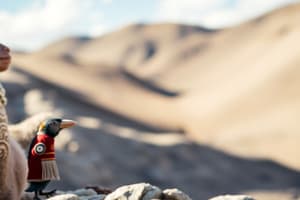Podcast
Questions and Answers
Which of the following groups were members of the Inca upper class?
Which of the following groups were members of the Inca upper class?
- Farmers
- Artisans
- Priests (correct)
- Kings (correct)
How were Inca government and religion related?
How were Inca government and religion related?
The Inca government and religion both allowed the people to choose freely about what they want, but still had some rules applied.
Why do you think Inca law outlined what clothes people of various classes could wear?
Why do you think Inca law outlined what clothes people of various classes could wear?
It helped establish who was a member of the upper class and who was a lower class member.
What was impressive about Inca masonry?
What was impressive about Inca masonry?
Were Inca oral traditions successful in preserving information? Why or why not?
Were Inca oral traditions successful in preserving information? Why or why not?
Why do you think the Incas wanted to connect all parts of their empire with roads?
Why do you think the Incas wanted to connect all parts of their empire with roads?
What was the significance of the sun god in Inca life?
What was the significance of the sun god in Inca life?
What types of sacrifices were commonly made to the sun god?
What types of sacrifices were commonly made to the sun god?
What characterized Inca artistic traditions?
What characterized Inca artistic traditions?
Describe the daily life of the lower class in Inca society.
Describe the daily life of the lower class in Inca society.
The term used for stonework in Inca culture is ______.
The term used for stonework in Inca culture is ______.
Flashcards are hidden until you start studying
Study Notes
Inca Life and Society
- Harsh conditions for lower class individuals contrasted with better living conditions for the upper class.
- The Inca Empire faced demise after Spanish conquest.
Class Structures
- Upper Class comprised of kings, priests, and government officials.
- Lower Class consisted of farmers, artisans, and servants.
Family Life
- Inca parents passed down knowledge and responsibilities to children, teaching them essential duties.
Warfare
- Conquered territories retained their lifestyle but were subject to Incan regulations.
Religious Beliefs and Practices
- The sun god held significant importance in Incan religion, with daily ceremonies often involving llamas or food sacrifices instead of humans.
Slavery
- Lower class individuals could find work, creating a structured workforce within society.
Artistic Traditions
- Art produced by the Incas featured meticulous precision and elaborate detailing.
Oral Traditions
- Cultural heritage preserved through songs and dances, ensuring continuity of the Inca legacy.
Architecture
- Inca masonry was remarkable; stones were cut so precisely that they did not require cement for stability.
- Infrastructure included buildings, forts, and extensive road networks facilitating travel.
Daily Life of Upper Class/Lower Class
- Upper Class sons attended specialized schools in Cuzco to prepare for future roles and lived in luxury while fulfilling responsibilities.
- Lower Class individuals primarily engaged in agriculture or military service, with limited educational opportunities mainly for girls learning weaving.
Religion
- The Inca religion was spread to conquered peoples, allowing for a diversity of beliefs.
- Sun god ceremonies reinforced ties between rulers and divine lineage, with the belief that kings were descendants of the sun.
Building and Art
- The Incas constructed monumental buildings from precisely fitted blocks.
- Artistry included exquisite jewelry and textiles, with unique creations like life-sized replicas of farms made from gold and silver.
Oral Literature
- Inca history and legends were conveyed through song and dance due to the absence of a writing system before Spanish contact.
- Spanish arrival brought literacy, leading to documentation of Incan stories.
Upper Class Members
- Members included kings, priests, and key government officials in society.
Government and Religion
- Both the Inca government and religion allowed personal freedom while enforcing certain regulations.
Clothing Regulations
- Laws dictated clothing for different classes to visually distinguish social standings within the empire.
Inca Masonry
- Remarkable stone cutting techniques resulted in buildings that held together without the need for cement.
Success of Oral Traditions
- Oral traditions effectively preserved Inca stories, as modern people still recognize and celebrate these narratives.
Purpose of Inca Roads
- Roads were built to ensure rapid access across the empire, particularly during emergencies or attacks.
Masonry
- Refers to the art and craft of stone construction, a hallmark of Incan architectural skill.
Studying That Suits You
Use AI to generate personalized quizzes and flashcards to suit your learning preferences.




